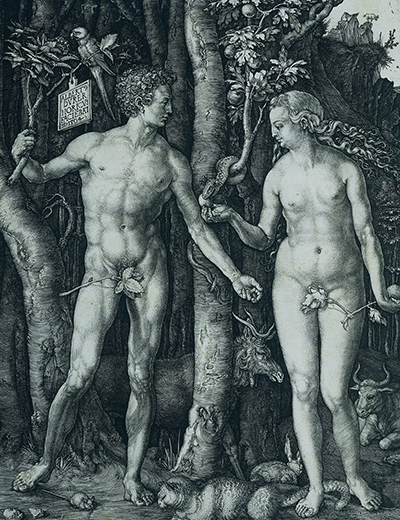This beautiful painting from 1526 is certainly one of the finest produced by German painter, Lucas Cranach the Elder. The artist himself produced several different interpretations of the iconic Adam and Eve theme.
Every last inch of the canvas is delivered with precision and consideration, leaving us with much to enjoy from right across the entire composition. Of course, your eyes will naturally be drawn to the two main figures initially, just as intended, but after this you will start to find all manner of exciting creatures and other items strewn across the scene. If feels as if the artist had fun putting this artwork together, particularly in the small animals placed nearer the bottom of the canvas, closest to us. Perhaps they will remind some of the work of Hieronymus Bosch, and the animals of fantasy that he put into the Garden of Earthly Delights, a famous artwork found at the Prado Museum in Madrid, Spain. Whilst the styles are similar, Cranach was only depicting creatures from reality, where as Bosch went deep into his creative mind to produce some bizarre and extraordinary sights.
The animals themselves are not there purely for aesthetic enjoyment, that just comes as an intended bonus. They each serve a symbolic role within the painting, with the full list of additions including a roebuck, stag, sheep, stork, heron, several partridges, plus a boar, a lion and a horse in all. Animals featured prominently in the work of a number of German artists during this period, as well as a number of other members of the North Renaissance. Perhaps Durer is the most well known of these, producing the likes of hare, owl and bluebird which remain some of the biggest highlights from his extensive career. There is certainly a cross over in the animals covered by both of these German artists, partly because of their presence locally, but also due to the inherent beauty of those particular choices.
Cranach was skilled in a number of artistic genres, including landscapes and portraits but he found specifically that the religious themes such as that of Adam and Eve would serve as popular gifts to his friends and colleagues. He was connected to many Lutherans and they appreciated artworks such as this willingly. Of course, the amount of work required for an oil painting of this scale meant that most of his gifts were on a smaller scale or in a simpler medium, such as a sketch. Cranach also ran a large workshop which enabled him to ask others to also address the same theme of Adam and Eve themselves, helping him to keep up with the considerable demands of pleasing his connections and also selling sufficient artworks to keep his studio profitable.








